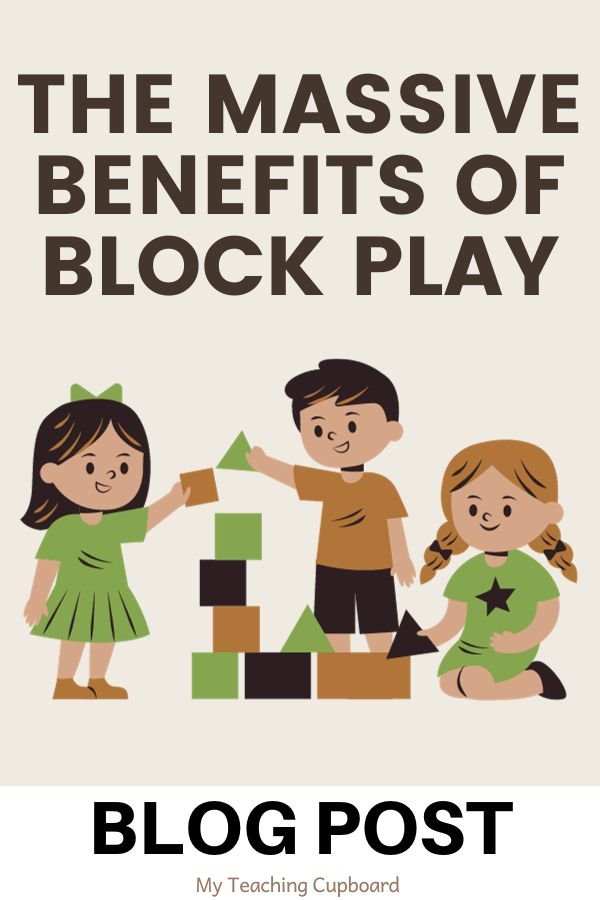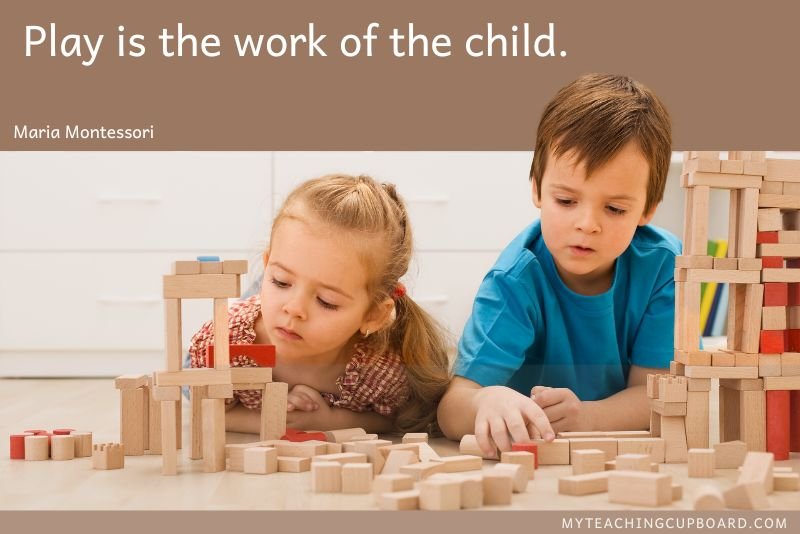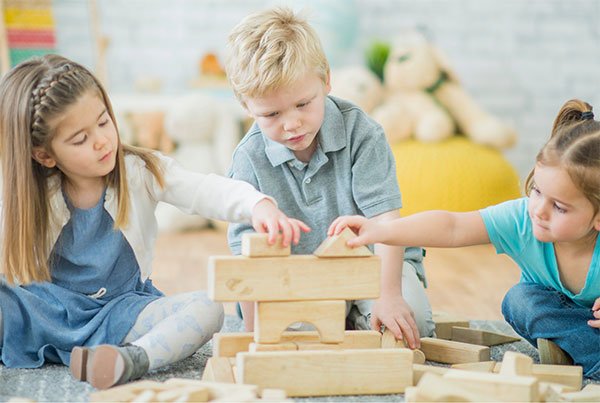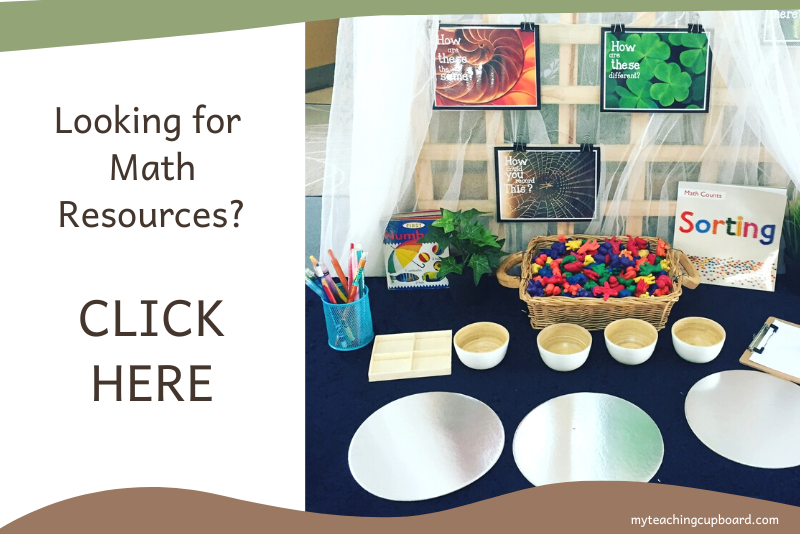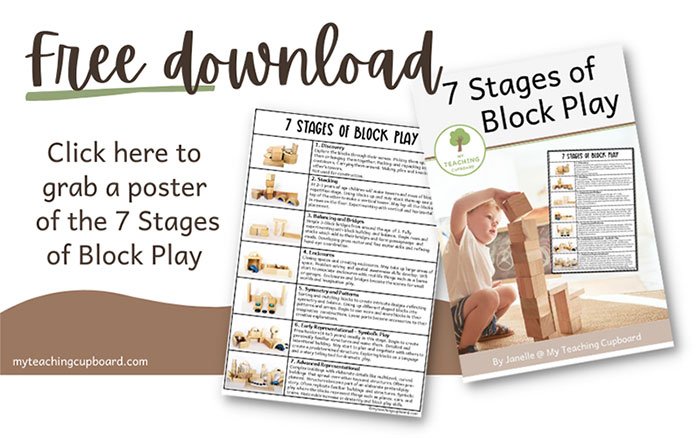Benefit of Block Play in Preschool and Beyond
Discover the wonderful benefit of block play in preschool, kindergarten and beyond. From cognitive development to essential life skills, discover why block play is a must-have activity in any early childhood classroom.
Have you ever watched young children completely engrossed in stacking and building with blocks? Block play is so much more than just play. Construction play like this is a critical part of their development.
I've had classes in my play-based classroom where the block area was the place to be and then other cohorts where I've had to lure them in with additional toys and prompts.
Is block play a good fit for all students?
Are you wondering if block play is right for your students? Well, the short answer is yes. The long answer is - Oh my goodness! You won’t believe how beneficial block play is. I believe block play is an indispensable part of any play-based classroom. Read on to see why…
Some years I have had kids in my class that are fascinated with blocks and go to the block area over and over during investigation or play time. I've even had to enlarge the space for their constructions. Other years the kids are just not that interested, and I've had to add loose parts and other child-interest items to the block area to entice them to play.
No matter what - block play is always a journey of discovery!
The blocks area is a staple in most play based learning environments. Most early childhood educators don’t even question the idea of including block play spaces in their classrooms.
If you are like me and want to ensure you provide the best learning experiences you can to your students, you will want to understand why blocks are so important before you follow this early childhood trend.
Why Is It Good for Kids to Play with Blocks?
Playing with blocks offers many tremendous benefits to young children. It's not just about keeping little hands busy or providing a resource that every other play-based teacher seems to have.
Block play is all about emotional growth, developing physical skills, cognitive skills and sparking creativity.
As Maria Montessori wisely said, "Play is the work of the child."
How Block Play Enhances Attention Span
When it comes to capturing a child's focus and attention, few activities are as engaging or as beneficial as block play. It's not just my personal observation either - there's quite a bit of scientific research to back up these claims.
This engaging activity captivates children's attention and builds concentration skills in a way that not many others can.
Time Flies When You're Building with Blocks
Because kids are so engrossed in achieving their vision, they will frequently spend more time at block play than they might with other investigation activities. It’s surprising to me and to the students that they often exceed their expectations of how long they can focus on a single task.
It’s not uncommon to see my students deeply engrossed in their block play in my classroom. They will spend ages designing and perfecting their creations.
Open-ended play, like block play, is highly engaging for young children. This is just one of the reasons block play is a staple in many preschool classrooms.
Stretching the Boundaries of Concentration
Playing with blocks involves problem-solving skills. Whenever there is a need for precise block placement or balanced blocks, problems arise and need to be solved.
This naturally challenges a child's ability to concentrate. The more opportunities young students have to engage in block play and concentrate, the more they improve their focus and attention span. You will notice these skills incrementally increase over time.
Perseverance and Determination: The Bonus Skills
Let’s not forget the bonus skills of perseverance and determination!
When children are committed to making their block-based vision a reality, they exercise these traits. Over time, these qualities become ingrained. Perseverance and determination are essential skills that will prepare your students for future academic success.
A longitudinal study in the National Library of Medicine stated that focused attention in young children is marked by sustained and active engagement with a stimulus or task (as compared with mere looking or ‘casual’ attention). The study found during periods of focused attention, cognitive information processing (i.e. learning) occurs (Ruff & Lawson, 1990; Ruff & Rothbart, 1996)), and young children are more impervious to external distractions when engaged in focused play (Choudhury & Gorman, 2000; Ruff & Capozzoli, 2003; Ruff & Lawson, 1990).
The Power of Perseverance
When children dive into a pile of blocks, they often have a vision they're determined to bring to life. This creative play might be about constructing the tallest tower they've ever built or creating a super fast ramp for their toy cars.
It doesn’t matter what the vision is. It’s all about the process!
In the process, young children can display incredible perseverance. They will work diligently until their vision materialises. Blocks are a great way for children to learn perseverance.
Interested in other great ways play-based learning can boost your student's attention span, improve their concentration and help them focus?
Check out my play based learning resources for an extensive collection of attention-boosting and highly engaging activities.👇
Motor Skills Developed Through Block Play
As simple as it might seem, the act of stacking, aligning, and manoeuvring blocks really does do wonders for a child’s physical development.
Let’s look a little closer at how the seemingly straightforward task of playing with blocks can develop both fine and gross motor skills in your students.
Gross Motor Skill Development
First, let's look at gross motor skills.
This is all about those large muscle movements that enable actions like jumping, running, and lifting. When children engage in block play, they frequently move around to collect blocks, bend over to place them, and even stretch to add that final piece to their towering masterpiece.
All these actions require the use of large muscles, and they all play their part in developing those all-important gross motor skills.
Fine Motor Skill Development
On the flip side, block play is just as beneficial to developing a child’s fine-motor skills. The more delicate, smaller muscle movements seen in block play predominantly involve the fingers and hands.
Lifting a block, balancing it on another, and adjusting its position requires a level of precision and control that can only come with practice and fine-tuned motor skills. The fine motor skills developed in block play are crucial for tasks that children will later perform in school, like writing or using scissors.
Hand-Eye Coordination
Block play develops spatial reasoning and hand-eye coordination too.
Hand-eye coordination is the body's ability to process information received through the eyes and then use that information to direct movements of the hands to complete a task. It relates to both simple and complex fine motor skills.
The development of motor skills in children has far-reaching implications. From holding a pencil and writing legibly to running and playing sports, these skills make everyday activities more accessible for children.
A strong foundation in fine and gross motor skills will set children up for greater independence and success in their daily tasks.
The Ripple Effect Motor Skills Have on Academic Life
As an early childhood educator, you know that as young children prepare to enter school, these motor skills will play an essential role in their school readiness. Walking up stairs, sitting on the carpet, pencil control, cutting along a line, and even pressing the keys on a keyboard all require refined motor skills.
Like me, you probably devote a decent amount of time to motor skill programs and activities in your early years classroom. Make sure to include block play.
Want to discover more play-based activities to enhance and develop your student's motor skills? Check out my hands-on learning resources for a selection of fine motor skill activities your students will love.
Building Social Skills One Block at a Time
Beyond the obvious motor and cognitive advantages, block play offers many social skill development opportunities too. When children play together in the blocks area, it becomes a unique social exercise.
I believe social development is one of the major benefits of building blocks.
Learning to Cooperate
When two or more children huddle around a collection of blocks, they're faced with the challenge of working together towards a mutual goal. It might be constructing a castle or building a zoo. Regardless - the need for cooperation quickly becomes evident.
Cooperation is more than merely taking turns building with the blocks. It involves a certain degree of empathy, patience, and collaborative thinking.
Learning the Dynamics of Give-and-Take
Teamwork in block play often requires a delicate balance of give-and-take. I have often observed my students when they realise that resources in the blocks area are limited. They have to
share blocks
agree on the project at hand
and sometimes compromise on their design elements.
This provides a natural setting for them to practise negotiation and conflict resolution skills. Skills like these are indispensable in both the general day-to-day of school life and essential later life skills as well.
A study published in the American Academy of Pediatrics indicates that cooperative play, like block building, can significantly improve children’s social interaction, including skills like sharing and negotiation.
The study concluded that kids need a range of skills to grow well and handle stress effectively. It showed that the right kind of play provides a unique chance to develop essential skills like social interaction, thinking, language, and self-control. These skills are part of what's called executive function, which helps us focus on goals and ignore distractions.
Block Play is Not Just for Fun!
It actually helps the brain grow and work better. It's especially good for developing the thinking processes that help children learn and reach their goals.
When kids miss out on play and strong, supportive relationships, it can result in harmful stress that interferes with their ability to develop these important skills.
In situations where kids face challenges or adversity, playtime becomes even more crucial.
Did you know that the joy and shared experiences kids and caregivers get from play can actually help regulate stress levels in the body?
Medical experts are starting to recognise the importance of play, and some are even prescribing play during regular health check-ups. This comes at a time when many early childhood programs are focusing more on academics and less on the value of playful learning. Doctors are now stressing the importance of a balanced education that includes play as a critical component for healthy child development.
Task Distribution and Leadership
Once a collective vision is agreed upon in the blocks area, task distribution often follows. This moment teaches children the concept of roles and responsibilities. Someone might be responsible for building the walls, while another focuses on crafting the towers.
This sense of shared responsibility fosters early leadership skills and the understanding of how teamwork can accomplish what individuals alone cannot.
Problem-Solving as a Team
Inevitably, disagreements will surface.
I’m sure you have been called to the blocks area to settle a dispute more than once!
Maybe two children have differing opinions on the height of a tower or the placement of a bridge. It's at these moments that young children learn to sort out disagreements constructively.
Rather than creating an argument, these disputes can become opportunities for learning how to communicate clearly, listen to others, and find a solution that respects everyone’s ideas.
Interested in teaching your students about their emotions and feelings, self-regulation and essential social skills like conflict resolution? Check out my play-based learning resources for a comprehensive collection of social skill resources and activities.
Learning Vital Scientific Skills through Block Play
Many early science concepts are learned with a set of building blocks.
As children engage in block play, they investigate early concepts of science that go well beyond the classroom curriculum. They explore the laws of gravity, understand the importance of weight distribution, and grasp the concepts of stability and balance. Every tower built and knocked down becomes a lesson in these scientific principles.
Block play is an activity that promotes many scientific principles.
Children also gain insights into cause and effect and scientific reasoning as they manipulate blocks. For instance, they quickly learn that a taller tower might require a broader base for stability, teaching them the interplay between weight, balance, and gravity.
They realise that different shapes and sizes of blocks serve various purposes, which helps them deepen their understanding of how objects relate to each other in space.
In essence, each block construction becomes a small-scale scientific experiment. You will see your students hypothesising, testing, and observing the outcomes, whether they're consciously aware of it or not.
Block play is invaluable for fostering a child's natural curiosity and laying the groundwork for future scientific inquiry.
Want to see all my play-based learning resources that will help you to teach the science curriculum? Check out my Science learning resources for an extensive collection of educational science lessons and activities.
Learning Vital Mathematical Concepts Through Block Play
You have no doubt seen that long before they're introduced to formal mathematical instruction, your students have come to school with some basic mathematical skills.
What is one of the most enriching activities for nurturing these skills? You guessed it - toy blocks.
Through the simple act of stacking, aligning, and constructing with blocks, young children lay the groundwork for so many mathematical understandings.
Just because you have students already counting up to ten, don’t dismiss block play's benefits for extending their growing mathematical understandings and skills.
Block play consolidates emerging math skills and knowledge.
For example, blocks can help a child visualise the conservation of numbers, learn about one-to-one correspondence or even begin to understand basic operations like addition, subtraction, and grouping.
As they're fully engrossed in their creative world of construction, young children will naturally explore more complex mathematical notions. They'll grasp the idea of needing 'one more block' to balance a tower or figure out how subtracting or adding blocks alters their architectural masterpiece.
But that's not where the learning stops.
Blocks serve as more than just a number exercise.
They're a hands-on classroom tool for developing measurement and spatial skills too. Students start comprehending 2D and 3D shapes and learning to, directly and indirectly measure heights, lengths and areas.
The beauty of block play is that it makes learning about numbers, sizes, and shapes an organic experience. Children are not merely absorbing these concepts. They're actively engaged in a problem-solving journey that feels more like fun than formal learning.
And that's why block play is so invaluable for our little learners in their formative preschool years… and beyond! The skills learned through block play are foundational skills. They will be built upon year after year.
Let’s look at the research around the value of block play.
There’s an interesting article in the Early Childhood Australia’s blog on Block play as an enduring, powerful toy. It discusses two decades of research showing that children build number and math skills from a very early age when they play with blocks.
This article also puts forward a convincing argument backed by research that those children who are strong in early math skills excel in math in their later years. Their research shows that children’s block play is related to later math competence and particular interests in STEM careers.
Teaching maths through play based learning is easy as!
Check out all my play-based Math learning resources HERE.
Oral Language and Block Play
We have seen how block play is a physical and a cognitive activity. It's a linguistic one too.
Children naturally express their thoughts and ideas as they immerse themselves in constructing various structures. This not only helps them articulate what they're envisioning but also provides a platform for language development.
While describing their creations, children encounter new words and concepts.
Whether they are interacting with a teacher or a friend, the language used can be quite rich and specialised. For example, you might ask a child about the stability of their tower or discuss the extension they're adding to a building. Words and concepts like levels, floors, ramp, complex, taller, and shorter are just some vocabulary you can introduce to your students when they build with blocks.
When children engage in block play with others, the experience becomes a collaborative dialogue. They will talk about what they're building, negotiate roles, and even provide constructive feedback to one another.
This social interaction serves as an authentic context for oral language development, allowing children to learn new words, sentence structures, and conversational cues in a meaningful setting.
Block play is not just about mathematical and scientific constructions. It is also about the rich, oral language experiences that come with it. These experiences lay a strong foundation for future communication skills.
Are you starting to see how block play is essential to a well-rounded, play-based curriculum?
Block Constructions are a Language
If you know anything about the Reggio Emilia Educational philosophy, you have no doubt heard about the concept of the 100 languages. The children in Reggio classrooms use one hundred languages to construct concepts and consolidate their understanding of the world around them.
If you are interested in learning more about this interesting idea, you should check out my blog post: 100 Languages of Children
In my blog post on the 100 languages, you will discover what the 100 languages of children means, where the idea started, why it is an important element of any child-centered education program and how you can use the 100 languages of children in your classroom.
Block play offers children an expressive medium – another language through which they can communicate. As much as drawing, painting, or storytelling are ways for children to express themselves, so is the careful selection and arrangement of wooden blocks. In this sense, block constructions become yet another language—one of the 100 languages through which children can express their understandings, ideas, questions, and wonderings.
Blocks are a rich medium that enables children to express their ideas. Each tower, bridge, or landscape they create is a testament to their inner thoughts, theories, and imaginings. Their constructions are so much more than just a physical structure.
The 100 languages philosophy places value on this kind of expressive capability. It tells us that children have multiple ways to convey their understanding and feelings, whether it's through words, movement, drawing, or in this case, building.
By not only offering, but also accepting a variety of ways for children to express themselves, we are fostering creativity and acknowledging and validating their diverse ways of seeing and being in the world.
In block play, every decision—from the kind of block chosen, to its placement—carries meaning. This form of self-expression empowers children, providing them with a sense of autonomy and confidence crucial for their self-esteem and overall emotional well-being.
By recognising and celebrating these 'languages,' educators can better understand their children and provide a more supportive, enriching learning environment for them to thrive in.
Fostering Creativity and Imagination Through Block Play
One of the most obvious benefits of block play is its ability to cultivate creative and imaginative thinking. When children build with blocks, it goes deeper than just building structures. These little engineers are building worlds.
Each block placement can represent anything from a castle turret to a car in a bustling city, limited only by the child's imagination.
Imaginative play is often observed when children build with blocks. These construction toys are just waiting to be transformed by a child's imaginative ideas. Block play can challenge young children to move beyond traditional thinking and to experiment. Can a block be a boat sailing on a blue fabric sea?
This free-form play, where structures don't have to conform to the rules of physics or societal expectations, helps to nurture a child’s creative process.
In the blocks area, children are the architects of their own worlds. They can freely explore abstract concepts and practice higher-level thinking that goes way beyond literal interpretations of their environment.
Not only does this foster immediate enjoyment and satisfaction, but it also sets the groundwork for innovative thinking in the future. The ability to think 'outside the block' 😉 is a skill that will serve children well as they navigate more complex problems and situations throughout their lives.
Blocks can become more than mere toys. They are tools for imaginative expression and creative problem-solving.
Block play is valuable play.
Given our rapidly changing world, these skills are not just beneficial - they're essential!
Block Play Promotes Problem Solving Skills
If you want your young students to be prepared for life after school, make sure block play is part of your school day. Current employers are looking for social skills and problem-solving abilities in their workers, and those skills will become more sought after in future years.
Right from the outset, a child playing with blocks embarks on a problem-solving journey. Before they even lay the first block, they need to conceptualise what they aim to build. Is it a skyscraper, a castle, or perhaps a sprawling zoo?
This initial planning stage is an exercise in foresight and vision. Skills developed at the planning stage are skills that will prove beneficial in various aspects of life.
But the learning doesn't stop at the planning stage. Next comes the implementation phase, where a child's ingenuity really shines. They need to figure out the logistics:
How will the structure maintain its balance?
What dimensions are needed for it to stand sturdy?
Should it be broad or tall?
Children will develop their mechanical understanding and reasoning abilities as they seek answers to these questions.
And let's not forget the inevitable hurdles along the way!
Maybe the roof keeps caving in, or perhaps the castle's gate is too narrow.
In these challenging moments, the gears in a child's mind start turning at full speed. Your students will have to think on their feet, re-evaluate their designs, and perhaps even go back to the drawing board.
The cognitive load here is immense and where some of the most profound learning takes place.
Don't underestimate the value of this early experience in problem-solving. What seems like simple play is actually laying the foundation for more complex thought processes that will be tapped into later for academic tasks, like solving math word problems or conceptualising a science project.
Block play isn't just child's play—it's an investment in developing the agile thinkers and problem solvers of tomorrow.
Want to learn more about Block Play?
You might be interested in learning about the various stages of block play and how these stages can and should influence the design of your classroom block play learning area.
You can learn a lot about a child's developmental level when observing the different structures they build because block play is linked to cognitive development.
Did you know there are 7 stages of block play?
Stage 1: Discovery - The first stage of block play where young children explore blocks through their senses, picking them up, mouthing them, and exploring sounds.
Stage 2: Stacking - Around 2-3 years of age, children begin basic block building and stacking.
Stage 3: Balancing and Bridges - At around 3-4 years old, children build simple bridges and passageways.
Stage 4: Enclosures - Around age 4, children start closing up spaces and creating enclosures.
Stage 5: Symmetry and Patterns - in this stage, children develop mathematical and scientific skills, focusing on symmetry and balance.
Stage 6: Early Representational or Symbolic Play - Typically, at 4-5 years old, children name their structures and engage in more intentional and functional building.
Stage 7: Advanced Representational - Around school age (5+ years), children build complex structures with details.
Check out this blog post: Stages of Block Play, if you want to learn more about these stages and how they can help you set up age-appropriate block play provocations.
You can also download a free block play poster illustrating these stages. Print it out and display it in your blocks area.
The Teacher’s Role in Block Play
Block play is not just an activity you can set up in your classroom and walk away from. Your role as a play-based educator is important and can be a transformative aspect of your teaching.
As a guide and facilitator, your involvement in block play can help your students to unlock new layers of understanding, encourage exploration, and foster collaboration.
Here's what your role in block play should look like:
Scaffold Learning: Present challenges or ask questions that provoke thought without providing direct solutions. For example, if a child's tower keeps falling over, you might ask, "What do you think would make it more stable?"
By scaffolding the student’s ideas using open-ended questions or making ‘I wonder’ and ‘I notice’ comments, you can get the most out of the block play in your classroom.
Introduce Vocabulary: While children are immersed in building, it's a great opportunity to introduce new words related to shapes, sizes, or physics, enriching their language and conceptual understanding.
Provide a Safe Space: Make sure the block area is safe, inviting, and equipped with various blocks and loose parts that cater to your young learners' diverse needs and interests.
Facilitate Social Interactions: Encourage sharing, cooperation, and conflict resolution when children are working together on a construction project.
Document & Reflect: Keep a record of the structures built, problems solved, and the language used during block play. Take note of who is working with whom and use your observations to create more advanced block provocations specifically designed to meet the developmental needs of your students.
I like to take photos and brief notes to remind me of what happens in the block play area. These documentation records can be powerful tools for reflection and assessment.
Observing children during block play will provide a wealth of insights into their developmental milestones, but doing so purposefully can often be challenging.
That's why I have created a Free Play-Based Learning Observation Checklist designed specifically for play-based teachers.
This checklist is a practical tool to make your observations more focused and meaningful.
If you are interested in fostering a rich block play experience for your students, you need to be making purposeful observations. Download your Free Play-Based Learning Observation Checklist and get the most from your block play area.
Conclusion
From boosting emotional and social skills to laying the groundwork for complex cognitive functions, block play is a crucial part of early childhood education and children's development.
It's more than just a fun activity.
It's a must-have component of any purposeful play-based classroom. The importance of block play cannot be overstated. After all the benefits of block play discussed in this blog post, I'm sure you will agree - Block Play is important for Preschool and Beyond!
Don't miss out on the chance to download my free printable poster illustrating the seven stages of block play. Print and display it in your blocks area to inform visitors and remind you of the developmental stages of block play.
Sign up for my free resource library today and enhance your block play area with The Stages of Block Play poster.
Found this blog post on the benefits of block play in preschool and beyond useful? Please consider sharing it 👇

